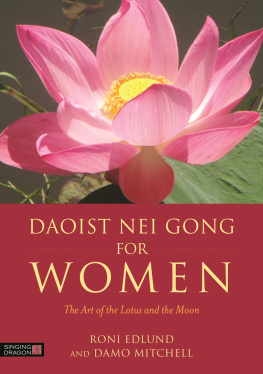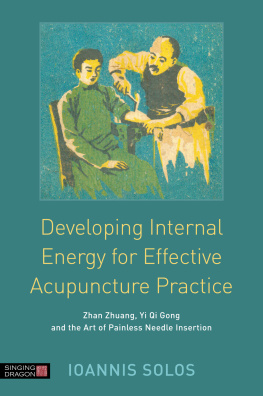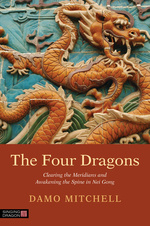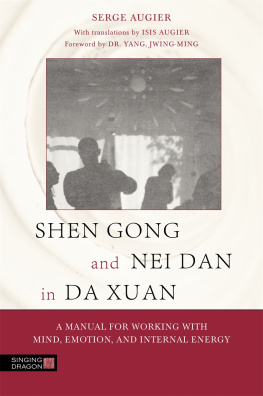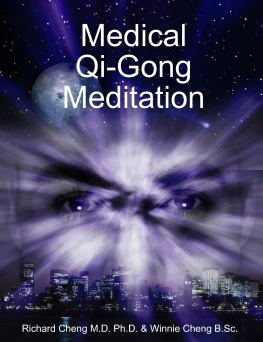Daoist Qi Gong
in Ten Exercises
Franklin Fick
Shen Long Publishing
www.shenlongpub.com
Shen Long Publishing
www.shenlongpub.com
Copyright Franklin Fick All Rights Reserved
First Edition 2003
Second Edition 2010
All rights reserved. No part of this book may be reproduced in any form or by any means, electronic or mechanical, including photocopying, recording, or by any information storage and retrieval system, without permission in writing from the publisher or author.
Layout, and illustrations by Franklin Fick
Disclaimer
This book is intended for informational purposes only. The author(s) and publisher of this book disclaim all responsibility for any liability, loss , injury, or risk, personal or otherwise, which is incurred as a consequence, directly or indirectly from reading and or following the instructions contained herein.
Please consult your physician before starting this or any exercise program.
Introduction
Qi
Qi is not something mysterious. It is all around us and animates everything including ourselves even if we are not aware of it. The most common translation for Qi is Energy and it is pronounced chee.
According to Traditional Chinese Medical Theory, Qi has different functions in the body and can be classified as different types of Qi depending on what function it is carrying out. Each organ has its own Qi because each organ has a certain function. The simplest and least esoteric way to look at and define Qi would be to say that Qi is the functional aspect of anything.
While there are many different types of Qi in the body, we take in or receive energy from only two main sources. One is finite and we inherit this from our parents and the universe at the time of our conception and the other we can constantly replenish through lifestyle, diet, and exercise. These two types of energy are classified as Pre-Heaven and Post-Heaven respectively.
Chinese theory states that we receive Energy from our parents when we are conceived. Because this Energy is given to us before we are born it is called Pre-Heaven Qi or Energy. In a western sense this type of Energy or Qi can be seen as our genetic makeup. This Energy is finite and can only be worn away or depleted with time.
After we are born we get our nourishment from the food we eat and the air we breathe. Our body processes the food and air to get all the nutrients and substances we need to keep our body healthy. This is called Post-Heaven Qi or Energy because this is how we nourish ourselves after we are born. Through Qi Gong exercise we can enhance the way the body takes in energy from the environment (breathing and digestion) and the way energy is utilized.
Each organ in the body has a different function and the Qi of the organ is said to carry out this function. Our organs are not independent things but instead they interact and depend on each other. When they are functioning properly they are in harmony. If the function of one organ is impaired it can effect the functional aspect of other organs.
Additionally each organ has its own energy pathway. These pathways are called meridians. The energy of the organ runs through these pathways and these pathways also connect with other meridians. This is another way that the organs are interrelated and connected. When an Acupuncturist places a needle into a meridian he or she is accessing the energy of that pathway and by doing so also the energy of the related organ. Because these pathways travel over every part of the body, exercise can also help to stimulate these pathways. Certain exercises and movements can also be used to stimulate specific meridians and organs.
In addition to the organs and meridians our body also has three centers or collection points. These are called Dan Tien, which translates as field of elixir. Inside our body these fields are a place for cultivation. As the name suggests the cultivation process is similar to the way crops are cultivated in a field, with much care for making sure the environment is right for cultivation but not much meddling in the actual process of transformation. If you grow a plant you can make sure the soil is fertile and that the seedling gets air, water, and sun. But the plant grows on its own. You can not really help it along, you can only observe the changes and transformations that take place and adjust the conditions accordingly. For personal practice this would relate to a healthy lifestyle, good nutrition, and consistent practice. Over time the transformations in the body will take place naturally.
These three centers house what are called the Three Treasures: Jing, Qi, and Shen.
The Lower Dan Tien is located about 2-3 inches below the umbilicus and at the center of the body. This center is associated with Jing. Jing is the most coarse substance of the three and relates to the physical body. Jing is often translated into English as sperm and is the origin of life.
The Middle Dan Tien is located in the middle of the chest at about the level of the solar plexus. This center is associated with Qi or Energy. This center also relates to the mind.
The Upper Dan Tien is located in the head and is related to Shen. Shen is thought of as spirit or consciousness.

The Three Treasures (Jing, Qi, and Shen) are all related and can support and transform into each other. They are actually the same substance at different levels of refinement.
Shen is more refined/rarefied Qi.
Qi is more refined/rarefied Jing.
Once Jing becomes abundant it will transform into Qi. Once Qi becomes abundant it will transform into Shen.
The three treasures relate to practice in that they emphasize the physical training first. The body is the same as a container that must be filled from the bottom up. This means that in order to practice safely and avoid problems always start by having a strong physical foundation through training. Once this strong foundation is achieved the mind and spirit will be supported and healthy. With a strong foundation we can achieve higher goals in cultivation. If the foundation of physical work is neglected the energy in the body can become ungrounded.
Qi Gong
Qi means Energy and Gong means Work. Literally Qi Gong means exercises that work with the bodys Energy or Qi. Qi Gong training has a very long history going back thousands of years. Over this long period of time many refinements have been made and many different exercises have been developed. Even though there are many different types of Qi Gong exercise most have a common goal. This goal is to harmonize the posture, breath, and mind. When this harmony is achieved it allows well-being and health to manifest. It is the disharmony of our internal body including the stagnation of Qi that creates disease and pain (both physical and emotional).
Qi Gong is a way for us to keep our body in harmony and take control of our health and well-being. Qi Gong can be practiced almost anywhere. It does not require lots of space or any fancy machines or equipment. The gentle, non-strenuous, circular movements work to twist our body and joints, not only stimulating our physical body of tendons, muscle, and organs but also our energetic pathways or meridians. This stimulation helps to maintain the free flow of Qi and Blood and break up any stagnation that might exist.
This free flow of Qi and Blood helps to ensure that the body gets the nourishment that it needs to functional at its optimal level as well as recuperate. Not only is the functioning enhanced but the bodys capacity to store and use Qi will also expand.
Next page

